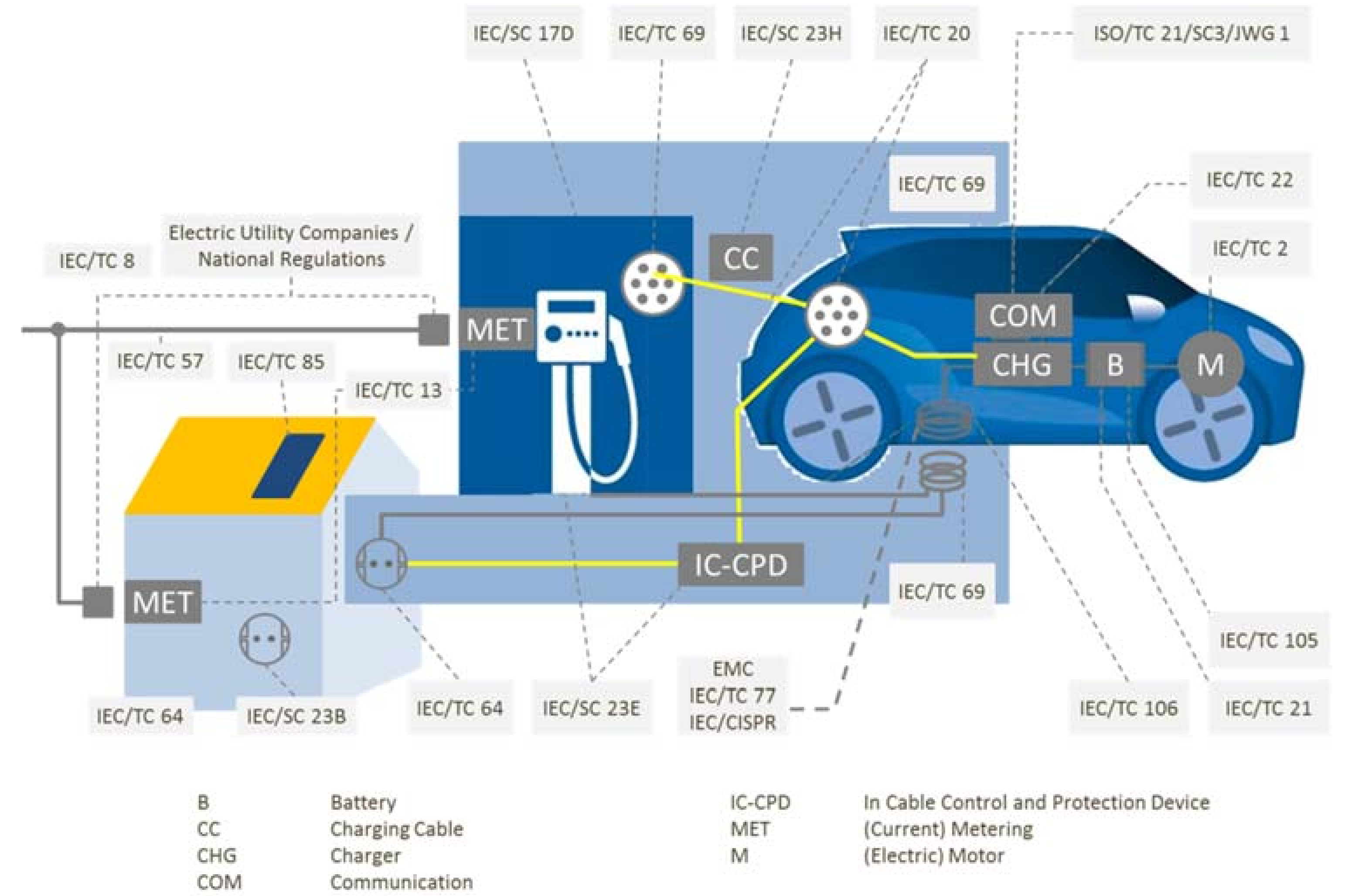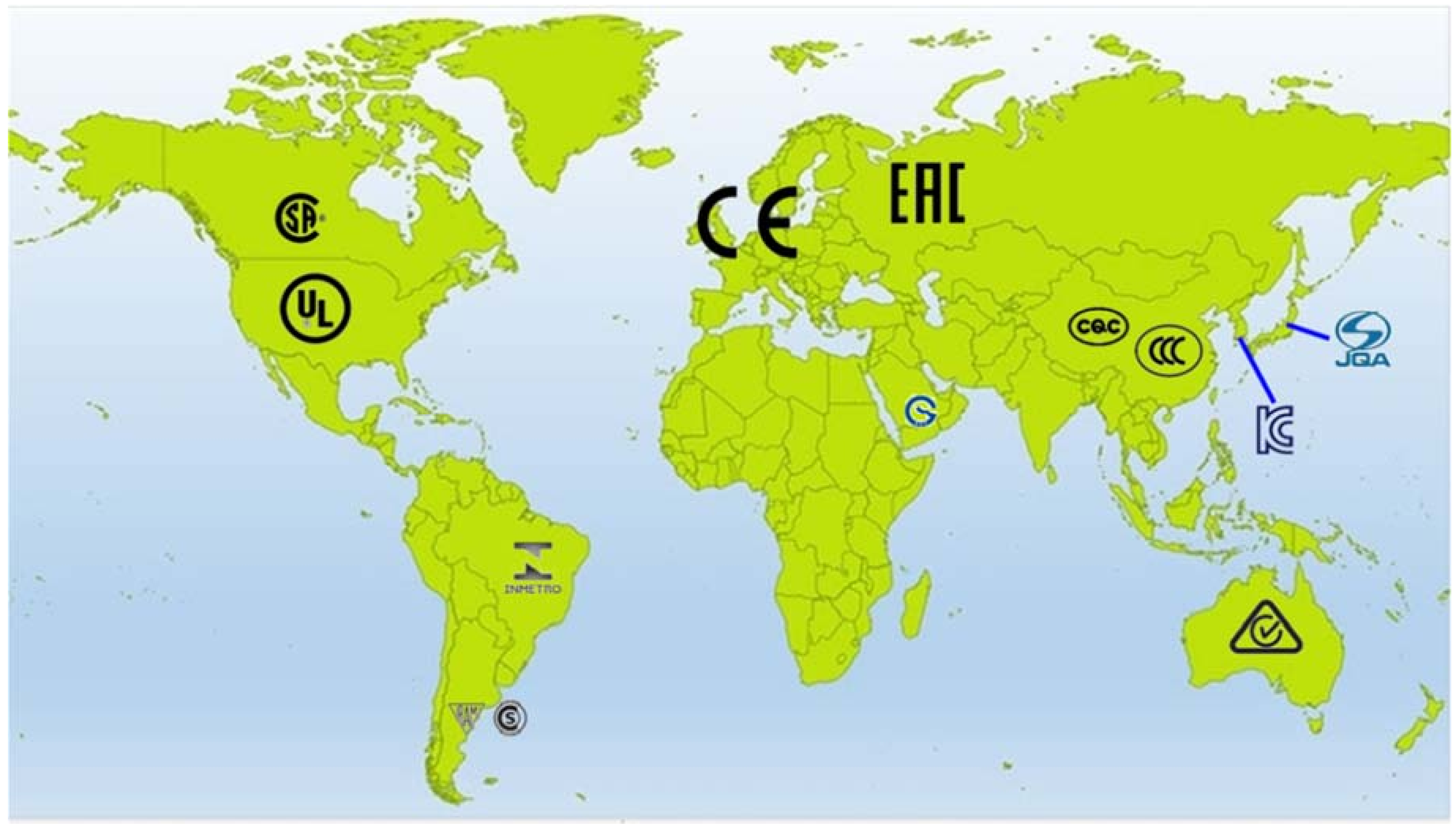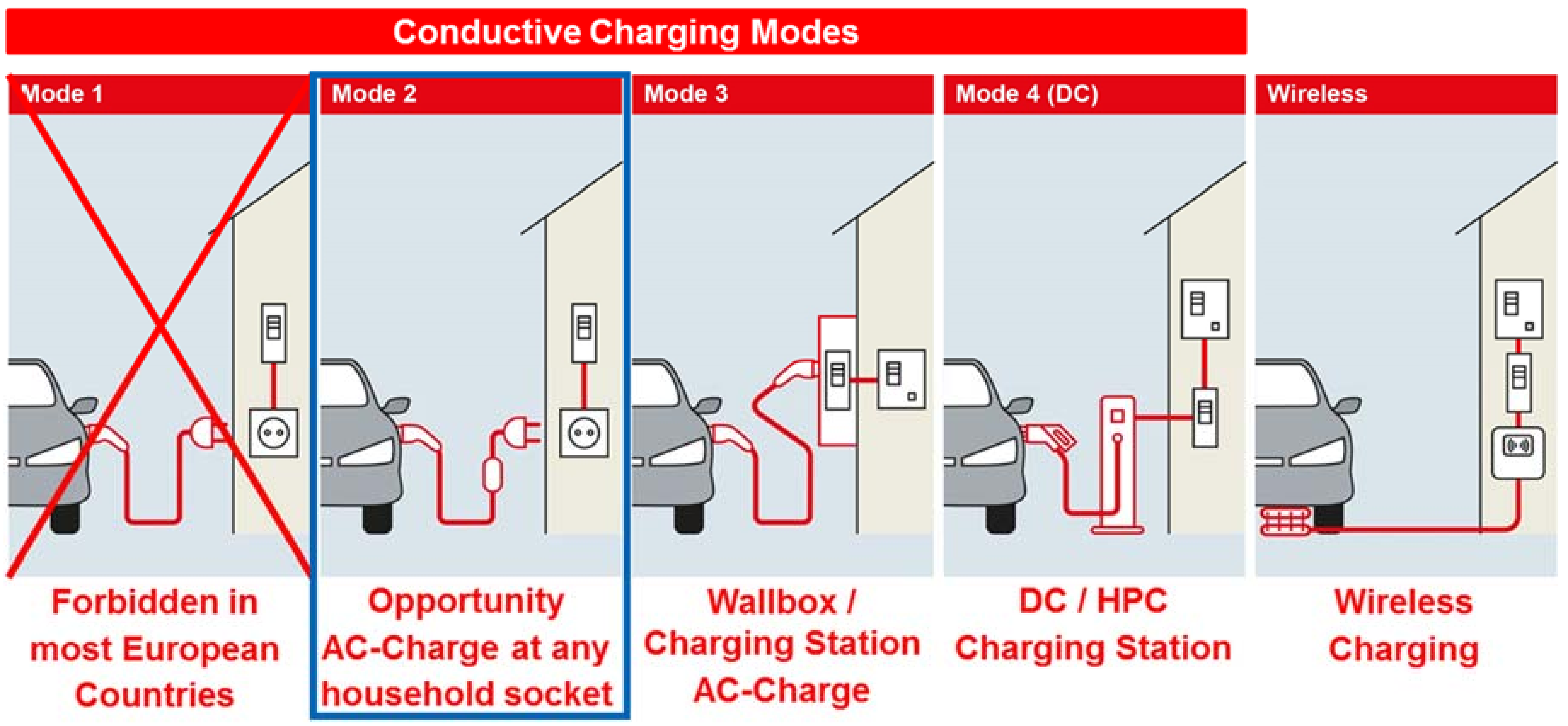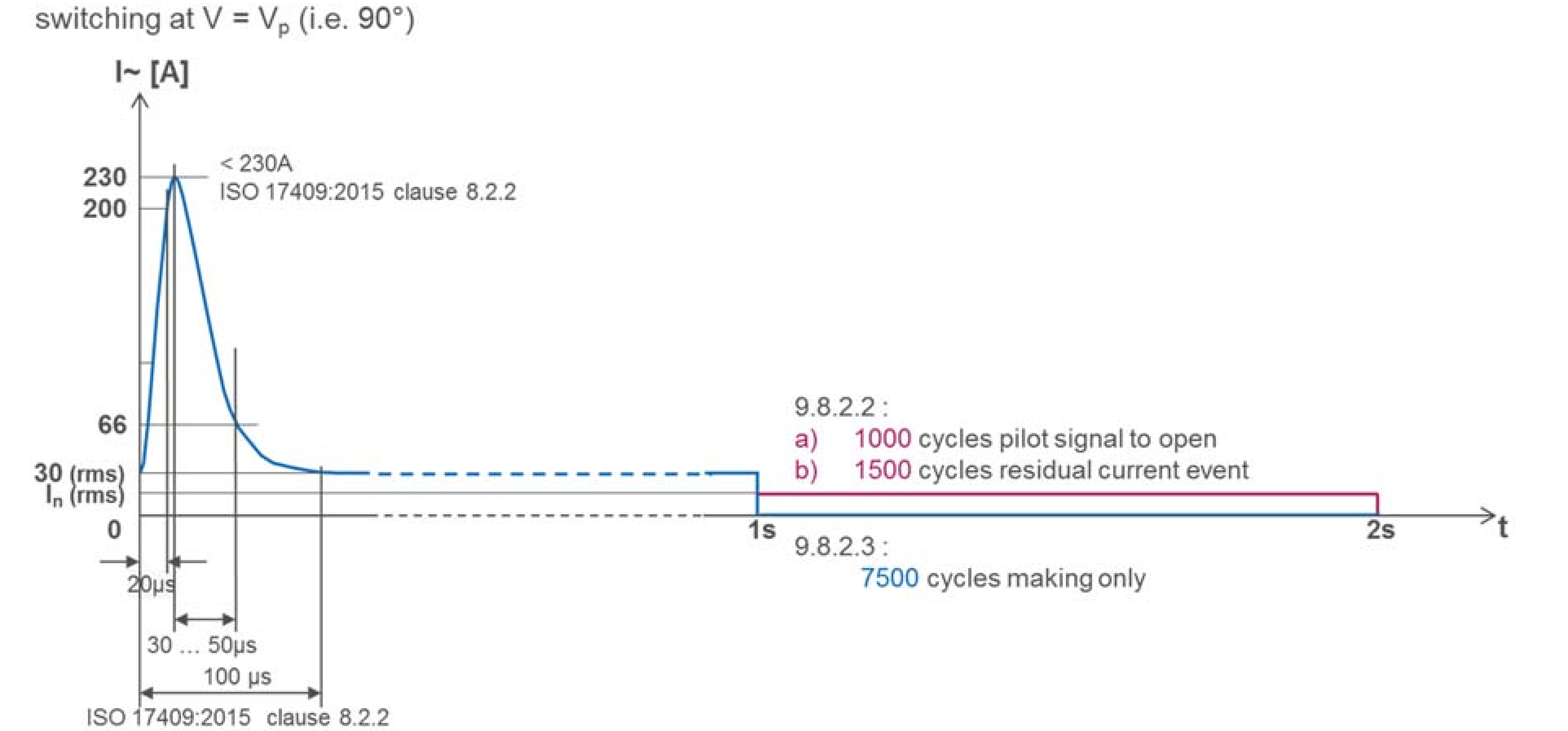Mode 2 Charging—Testing and Certification for International Market Access
Abstract
:1. International Standardization and Regulation
1.1. Standardization Groups and Trading Zones
1.2. Current Activities in Standardization
- Improving the IEC 62752 standard to implement actual development.
- Standardization for pluggable/portable Electric Vehicle Supply Equipment (EVSE) will be implemented in the Amendment of IEC 62752:2016. An Amendment will be published next year.
- IEC 61851-1:2017 has become a system standard for charging electric and hybrid electric vehicles.
- The standard for Residual Direct Current Detecting Devices (RDC-DD) IEC 62955:2017 is on revision at the European Committee for Electrotechnical Standardization (CENELEC).
- Charging cables are specified in IEC 62893-1:2017, IEC 62893-2:2017, and IEC 62892-3:2017.
- Requirements for Electromagnetic compatibility (EMC) with respect to charging of electric and hybrid electric vehicles have been published in IEC 61851-21-1:2017 for “on-board charger” and IEC 61851-21-2:2018 for “off-board charger”.
- Standardization for high-power DC charging, as an extension of IEC 61851-23, is in CD state. The scope has been extended to 1500 V DC charging voltage. Within the 2nd CD a maximum nominal current of 400 A is specified. But this value is in discussion.
- Standardization for bi-directional charging (load leveling) has been started and will be implemented in IEC 61851-23.
- IEC 61851-24 is in maintenance status and will include so-called high-power charging with cooling.
- Extension of IEC 62196-1 for high-power charging is in CD state.
- New IEC 62196-3-1 for so-called high-power charging with cooling is also in CD state.
- Standardization for wireless charging is ongoing (IEC 61980-1:2015).
- Standardization for e-Bikes, e-Scooters, and even trucks and buses has started.
- etc.
2. Mode 2 Charging Equipment
2.1. Overview of Different Charging Modes
- Type 1 connection is based on the standard SAE J1772. SAE International is a standardization organization in the United States of America.
- Type 2 connection will be the standard AC connection within Europe
- Type 3 connection is a special AC connecting system using shutters
- AA describes a connection according to CHAdeMO specification
- BB connection is used in China
- EE connection is a combination of DC and Type 1 (SAE J1772) connections
- FF connection is a combination of DC and Type 2 connections
2.2. Technical Issues: Why to Use Mode 2 Charging
- Example 1 of Figure 4: Within households, installation of a broken phase (L) or neutral (N) line can happen because of a loose connection over time. This fault is obvious, because the electric equipment does not work. So, an electrician can be ordered to fix it.
- Example 2 of Figure 4: A broken protective ground (PE) line is not obvious, but a concealed defect. Because this is not an obvious fault, it can be there for a long time before being recognized. The reason for this can also be a loose connection over time. If a ground fault occurs in cable-connected Class I equipment, an electric shock can happen. This is the reason for installing RCDs in the house. As mentioned before, this is not always available in older houses. This example illustrates why there is the demand for the detection of an “open protective conductor” within IEC 62752.
- Example 3 of Figure 4: In older houses, PEN lines might be installed. If there is an open PEN line, the cable-connected equipment does not work, like in Example 1. This obvious fault can be repaired by an electrician.
- Examples 4 and 5 of Figure 4: If somebody did a job incorrectly, phase (L) and protective ground (PE) or PEN may have been connected incorrectly, as indicated. If Class II appliances are used, they do not work, and because of the nature of Class II, there is no danger. However, if Class I appliances are connected to this socket, the enclosure of the appliance is connected to phase (L). In this case, even an RCD is of no value, because there is no difference in current flow between PE and N or PEN and L.
- These examples show the need for a product with a “switched protective conductor”. A life protective conductor can be switched off and, therefore, no line voltage is on the vehicle chassis any longer.
2.3. Contactor Requirements
2.4. DC Residual Current Protection
2.5. National Requirements
- USA;
- Canada;
- Mexico;
- Japan; and
- China.
3. Conclusions
Funding
Conflicts of Interest
References
- IEC System of Conformity Assessment Schemes for Electrotechnical Equipment and Components (IECEE). IECEE and CB Scheme; International Electrotechnical Commission: Geneva, Switzerland, 2016; Available online: https://www.iecee.org/documents/presentations/ppt/iecee-and-cb-scheme_2016-08.pptx (accessed on 20 July 2018).
- International Electrotechnical Commission. IEC 61851-1:2017-02 “Electric Vehicle Conductive Charging System—Part 1: General Requirements”; International Electrotechnical Commission: Geneva, Switzerland, 2017. [Google Scholar]
- International Electrotechnical Commission. IEC 62196-1:2014-6 “Plugs, Socket-Outlets, Vehicle Connectors and Vehicle Inlets—Conductive Charging of Electric Vehicles—Part 1: General Requirements”; International Electrotechnical Commission: Geneva, Switzerland, 2014. [Google Scholar]
- International Electrotechnical Commission. IEC 62196-2:2016-02 “Plugs, Socket-Outlets, Vehicle Connectors and Vehicle Inlets—Conductive Charging of Electric Vehicles—Part 2: Dimensional Compatibility and Interchangeability Requirements for a.c. Pin and Contact-Tube Accessories”; International Electrotechnical Commission: Geneva, Switzerland, 2016. [Google Scholar]
- International Electrotechnical Commission. IEC 62752:2016-03 “In-Cable Control and Protection Device for Mode 2 Charging of Electric Road Vehicles (IC-CPD)”; International Electrotechnical Commission: Geneva, Switzerland, 2016. [Google Scholar]
- International Electrotechnical Commission. IEC 60364-1:2005-11 “Low-Voltage Electrical Installations—Part 1: Fundamental Principles, Assessment of General Characteristics, Definitions”; International Electrotechnical Commission: Geneva, Switzerland, 2005. [Google Scholar]
- Elektro-Beratung Bayern, Landwirtschaftlicher Prüfdienst (EBB). Statistik der Prüfung der elektrischen Anlagen und Energieverbrauchsgeräte von Landwirtschaftlichen Betrieben in Bayern im Jahr 2008—Gesamtübersicht; Elektro-Beratung Bayern, Landwirtschaftlicher Prüfdienst: Munich, Germany, 2009. [Google Scholar]
- International Organization for Standardization. ISO 17409:2015-11 “Electrically Propelled Road Vehicles—Connection to an External Electric Power Supply—Safety Requirements”; International Organization for Standardization: Geneva, Switzerland, 2015. [Google Scholar]







| Standardization | Regulation | |||
|---|---|---|---|---|
| General | Electro-Technics /Electronics | Telecommunication | ||
| International Standardization |  |  |  |  |
| European Standardization |  |  |  |  |
| National Standardization (example Germany) |  |  |  | National Regulation |
| Charging Mode | Description | Maximum Current and Voltage |
|---|---|---|
| Mode 1 | conductive connection between a standard socket-outlet of an AC supply network and electric vehicle (EV) without communication or additional safety features | 16 A and 250 V AC, 1-phase 16 A and 480 V AC, 3-phase |
| Mode 2 | conductive connection between a standard socket-outlet of an AC supply network and electric vehicle with communication and additional safety features | 32 A and 250 V AC, 1-phase 32 A and 480 V AC, 3-phase |
| Mode 3 | conductive connection of an EV to an AC EV supply equipment permanently connected to an AC supply network with communication and additional safety features | 1: 32A and 250 V AC, 1-phase 2: 70 A and 250 V AC, 1-phase 63 A and 480 V AC, 3-phase 3: 16/32 A and 250 A AC, 1-phase 63 A and 480 V AC, 3-phase |
| Mode 4 | conductive connection of an EV to an AC or DC supply network utilizing a DC EV supply equipment, with (high-level) communication and additional safety features | AA: 200 A and 600 V DC BB: 250 A and 600 V DC EE: 200 A and 600 V DC FF: 200 A and 1000 V DC |
© 2018 by the author. Licensee MDPI, Basel, Switzerland. This article is an open access article distributed under the terms and conditions of the Creative Commons Attribution (CC BY) license (http://creativecommons.org/licenses/by/4.0/).
Share and Cite
Hanauer, D. Mode 2 Charging—Testing and Certification for International Market Access. World Electr. Veh. J. 2018, 9, 26. https://doi.org/10.3390/wevj9020026
Hanauer D. Mode 2 Charging—Testing and Certification for International Market Access. World Electric Vehicle Journal. 2018; 9(2):26. https://doi.org/10.3390/wevj9020026
Chicago/Turabian StyleHanauer, Dieter. 2018. "Mode 2 Charging—Testing and Certification for International Market Access" World Electric Vehicle Journal 9, no. 2: 26. https://doi.org/10.3390/wevj9020026
APA StyleHanauer, D. (2018). Mode 2 Charging—Testing and Certification for International Market Access. World Electric Vehicle Journal, 9(2), 26. https://doi.org/10.3390/wevj9020026





